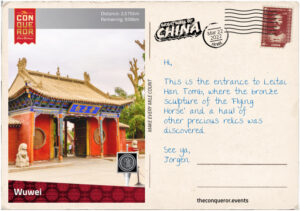Vår vandring går vidare och vi har fått vårt tjugofjärde vykort från den kinesiska muren.

Tjugofjärde vykortet.
In ancient times, Wuwei was an important town along the Hexi Corridor, a significant trading route that connected central China to the western regions. This 620mi (1000km) passage was linked by Wuwei, as its eastern terminus, to Yumen Pass, in the west. The Corridor, an arable plain, was long and narrow, sandwiched between the inhospitable plateaus of Mongolia to the north and Tibet to the south. It became a hub for the ancient silk road.
During the 2nd century BC, the Hexi region was reigned by the Xiongnu, a nomadic tribe, until a Han General, on the orders of his emperor, conquered the tribe and took over the corridor. As a result, Wuwei became a provincial capital of the Han Dynasty. Driving the Xiongnu out allowed the emperor to expand the corridor westward and protect the goods traded along the Silk Road.
In 1969, a group of farmers, digging air-raid shelters underground, unearthed a Han tomb belonging to an army general. Within, they discovered more than 200 relics consisting of wares made of precious metals, potteries, ceremonial figurines and a horse sculpture made of bronze known as the ‘Flying Horse of Gansu’.
The sculpture is an incredibly valuable piece, so much so that it is listed as one of 64 cultural relics prohibited from ever being exhibited outside of China. The horse is meant to depict the Ferghana breed (from modern-day Uzbekistan), that was highly prized by the Han emperor for its speed, hardiness and endurance. He went on to name the breed ‘heavenly horses’, after he was told that divine horses would appear from the northwest. The artwork itself is brilliant as the horse, in a galloping state, is balanced by one hoof resting without pressure on a flying swallow. The sculpture became a symbol of Wuwei City and it is used as a logo for China Tourism.